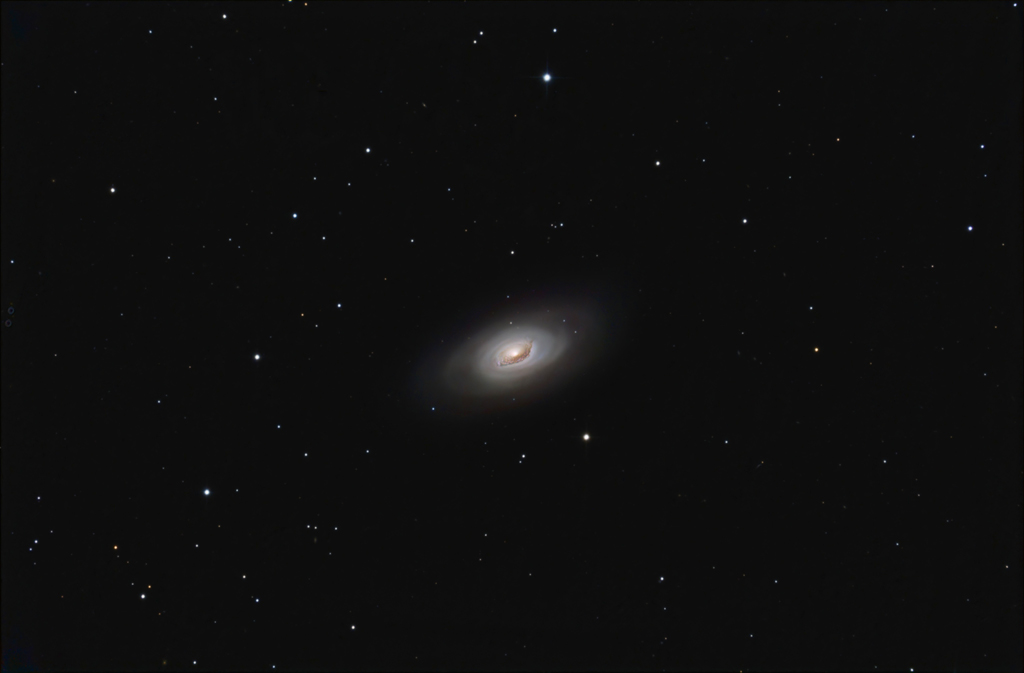 |
CHAMÄLEON + ONJALA OBSERVATORY DeepSky | SITEMAP HOME CHAMÄLEON |
|
 |
|||
| « zurück zur Startseite
Galaxien « back to home galaxies |
Großes Bild laden - load large image 2048 x
1400 Pixel Aufnahmedaten Image data |
Messier 64 - the "blackeye" galaxy in the constellation Coma Berenice

Messier 64 - Unser Bild zeigt in höherer Bildauflösung die so genannte "blackeye" Galaxie Messier 64 (NGC 4826) im Sternbid Haar der Berenike (Coma Berenice). Sie wird nach Hubble der Klasse Sa-b zugeordnet und liegt etwa 18 Millionen Lichtjahre vom Sonnensystem entfernt und mit einem wahren Durchmesser von ungefähr 50.000 Lichtjahre nur etwa halb so groß die die Milchstraße.
M 64 ist aufgrund einer zum Kernbereich liegenden asymetrisch großer ovaler Dunkelwolke nördlich des Kerns mit einer Ausdehnung von etwa 8000 Lichtjahren absolut einzigartig. Beobachtungen haben gezeigt, das Gas der äußeren und der inneren Regionen in entgegen gesetzten Richtungen rotieren. Vermutlich ist M 64 vor rund einer Milliarde Jahren mit einer kleinen, sehr staubreichen Galaxie, verschmolzen. Damit ließen sich die einseitige Konzentration der Dunkelwolke und die vielen in Kernnähe stehenden Regionen mit ungewöhnlich kräftiger Sternentstehung erklären.
Die Galaxie wurde am 23. März 1779 von dem britischen Astronomen Edward Pigott in Wales entdeckt. Friedrich William Herschel berichtete als erster über den dunklen Fleck nördlich des Kerns. Nachdem er diesen dem britischen Physiker Charles Blagden am Teleskop gezeigt hatte, verglich dieser die Dunkelwolke mit einem blauen Auge (englisch black eye). Einen tiefen Blick in die Dunkelwolke lieferte das Weltraumteleskop Hubble im Jahr 2021
Object description
Messier 64 - Our image shows in higher image resolution the so called "blackeye" galaxy Messier 64 (NGC 4826) in the starbid Haar of Berenice (Coma Berenice). It is assigned to class Sa-b according to Hubble and is located about 18 million light-years away from the solar system and with a true diameter of about 50,000 light-years only about half the size of the Milky Way.
M 64 is absolutely unique due to an asymmetric large oval dark cloud north of the core with an extension of about 8000 light years. Observations have shown that gas from the outer and inner regions rotate in opposite directions. Probably M 64 merged with a small, very dusty galaxy about one billion years ago. This could explain the one-sided concentration of the dark cloud and the many regions near the core with unusually strong star formation.
The galaxy was discovered by the British astronomer Edward Pigott in Wales on March 23, 1779. Frederick William Herschel was the first to report the dark spot north of the nucleus. After he showed it to the British physicist Charles Blagden at the telescope, the latter compared the dark cloud to a black eye. A deep look into the dark cloud was provided by the Hubble Space Telescope in 2021.
Messier 64 - the "blackeye" galaxy in the constellation Coma Berenice
Image data
Date: some nights in june 2022 - 15 x 600 s, QHY ALccd 12 (cooled)
Telescope: CDK 12.5" PlaneWave Astrograph + 0.8x Reducer at f = 2030 mmm
Location: Chamäleon Observatory, Onjala Lodge, Namibia
Image acquisition and processing: DeepSkyStacker, PixInsight + Photoshop by Bernd Gooßmann
 |
 |
 |
 |
 |
 |
 |
| Sonne | Mond | Sonnensystem | DeepSky | Weitwinkel | Verschiedenes | Spez. Projekte |